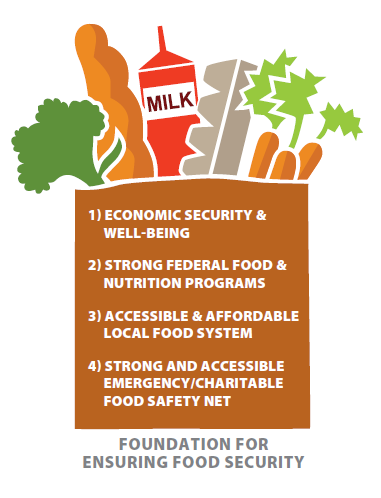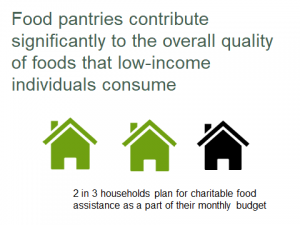The number of individuals who rely on food pantries to meet their food needs has increased 64% in Wisconsin since 2007[1]. As more Wisconsinites turn to food pantries to meet their food needs, it is important that food pantries consider their role in supporting the health and well-being of their clients. They can do this by working to improve the nutritional quality and safety of the foods they offer.

More than 1 in 9 Wisconsin households are food insecure, meaning they lack assured access to sufficient foods to support a healthy and active life[2]. Meanwhile, 2 in 3 low-income Wisconsinites are overweight or obese and 1 in 10 has diagnosed diabetes[3]. Rising rates of obesity and diabetes in recent years have highlighted the burden of these diseases on society, and are calling for action across all community sectors.

Ensuring food security for all households requires a foundation of four strong factors:
- family economic security and well-being;
- adequate access to healthy and affordable food;
- use of federal nutrition programs; and
- access to emergency / charitable food safety net, which includes food pantries.
Food Pantries contribute significantly to the overall quality of foods that low-income individuals consume.  A 2014 Feeding America Hunger Study found that nearly 2 in 3 households plan for charitable food assistance as a part of their monthly household budget[4]. This means that food pantries contribute significantly to the overall quality of foods that low-income individuals consume.
A 2014 Feeding America Hunger Study found that nearly 2 in 3 households plan for charitable food assistance as a part of their monthly household budget[4]. This means that food pantries contribute significantly to the overall quality of foods that low-income individuals consume.
Linking Food Insecurity & Health
Food insecurity has negative impacts on health including nutrient deficiencies, low birth weight, premature birth and chronic stress(5). It becomes difficult to manage chronic diseases, such as hypertension and diabetes, when also struggling to meet basic food needs (6). Food insecurity has also been found to be associated with overweight and obesity.
Further, a recent study reports that factors that increase the risk of foodborne illness include stress, pregnancy, age under five years or between 60-65 years, nutritional deficiency, and the ingestion of fatty foods (7)
Food pantries can address this risks by providing safe and healthy foods.
Who should use the Safe & Healthy Food Pantries Project guide?
All food pantries play a role in supporting the health of their guests. This guide is intended to assist coordinators and volunteers of food pantries to make improvements in the food pantry environment that optimize the nutritional quality and safety of foods distributed while also supporting food security.
While this guide was designed especially with guest choice food pantries in mind, certain strategies presented in this toolkit can be applied to any pantry.
[1] Wisconsin Community Action Program Association TEFAP & Food Security Report. November 2014.
[2] Coleman-Jensen, Alisha, Christian Gregory, and Anita Singh. Household Food Security in the United States in 2013, ERR-173, U.S. Department of Agriculture, Economic Research Service, September 2014
[3] Wisconsin Interactive Statistics on Health (WISH), 2010 Behavioral Risk Factor Survey. WI Department of Health Services, Office of Health Informatics, Division of Public Health. Accessed at https://www.dhs.wisconsin.gov/wish/brfs/index.htm
[4] Feeding America Hunger in America 2014. Accessed online at http://www.feedingamerica.org/hunger-in-america/our-research/hunger-in-america/
[5] Cook, John T., Deborah A. Frank, Carol Berkowitz, Maureen M. Black, Patrick H. Casey, Diana B. Cutts, Alan F. Meyers, et al. “Food Insecurity Is Associated with Adverse Health Outcomes among Human Infants and Toddlers.” The Journal of Nutrition 134, no. 6 (2004): 1432–38.
[6] Berkowitz, Seth A., Travis P. Baggett, Deborah J. Wexler, Karen W. Huskey, and Christina C. Wee. “Food Insecurity and Metabolic Control Among U.S. Adults With Diabetes.” Diabetes Care, June 11, 2013.
[7] Food Research and Action Center. Relationship Between Hunger and Overweight or Obesity. Accessed at http://frac.org/initiatives/hunger-and-obesity/are-hunger-and-obesity-related/
[8] Lund, Barbara M., and Sarah J. O’Brien. “The Occurrence and Prevention of Foodborne Disease in Vulnerable People.” Foodborne Pathogens and Disease 8, no. 9 (September 2011): 961–73.



